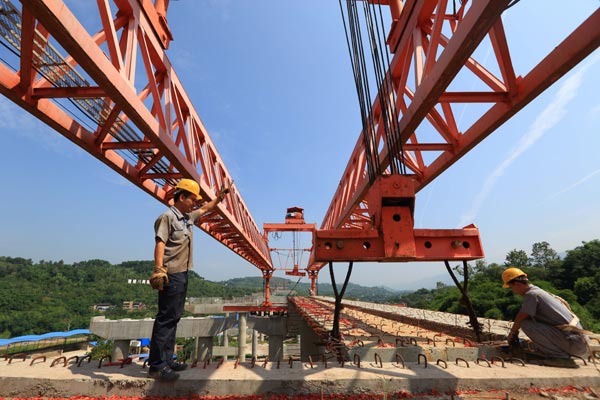|
 |
|
Construction workers complete a bridge project on the Chongqing-Guang'an highway on Thursday. Work on the 79-kilometer roadway is progressing steadily and is expected to be finished by the end of 2016. [Photo/China Daily] |
The growth of China's local government debt has drastically slowed since the last audit in mid-2013, which analysts said reflects regulators' yearlong curb but raises concerns that it could curtail the nation's debt-driven growth.
A spot check carried out by the National Audit Office showed that from the end of June 2013 to the end of March this year, outstanding debt at nine provincial and nine city-level governments across China grew 3.79 percent, 7 percentage points lower than the expansion rate during the first half of 2013, Xinhua News Agency reported on Sunday, citing NAO officials.
The report did not specify the provinces and cities being audited. It did not explain whether the "debts" referred to were those directly raised by local governments or loosely defined debt.
The latest figure contrasts starkly with the result of the last comprehensive audit, which showed from the end of 2010 to the end of June 2013, direct and contingent liability of local governments rose 67 percent to 17.9 trillion yuan ($2.93 trillion). From 2011 through 2012, debt expanded at an annual rate of 21.9 percent.
Various factors contributed to the slowdown, analysts said. Last December, the party's personnel department made local government debt a major criterion in the evaluation of local officials. Under the previous evaluation system, local officials had an "impulse" to raise mounting debt to fuel GDP growth in a short time.
Another possible factor, according to Shi Hongxiu, a public finance professor with the Chinese Academy of Governance, is that central government's clearing of the so-called "local government financing
The central government has vowed to replace irregularly raised debts with standard government bonds, and the clearing and consolidation of LGFVs has been occurring since 2010. According to the Ministry of Finance estimates, 154,000 borrowers are involved at various levels in government organizations and SOEs, using more than 30 financing tools. Since 2010, bank loans to LGFVs have been under strict scrutiny, driving local governments to various less-regulated channels, the so-called "shadow banking", usually with a short maturity and high interest rate. Li Yan, an analyst at China Chengxin International Credit Rating Co Ltd, said the banking regulator's crackdown on non-standard assets - those debt-financing instruments that are not traded on either stock exchanges or the interbank market - since last year put the brake on LGFVs' alternative financing. "My on-site study showed that LGFVs now find it extremely difficult to access bank loans, and other channels, such as trusts, are also increasingly difficult," Shi said. However, as local government spending on infrastructure comprises a large portion of China's fixed-asset investment, and investment is the essential driver of growth, the low growth in local government debt has triggered some worries. A grinding halt in financing also threatens repayment. An official from the Ministry of Finance said in June that 21.89 percent of the outstanding local government debt, or 2.4 trillion yuan, will mature by the end of this year. "If financing is broken off and projects are left half-built, that is a greater waste. The central government knows this situation and that's why it permitted some refinancing. A sudden hard landing is not possible," Li said.
 |
 |
|
|
|
